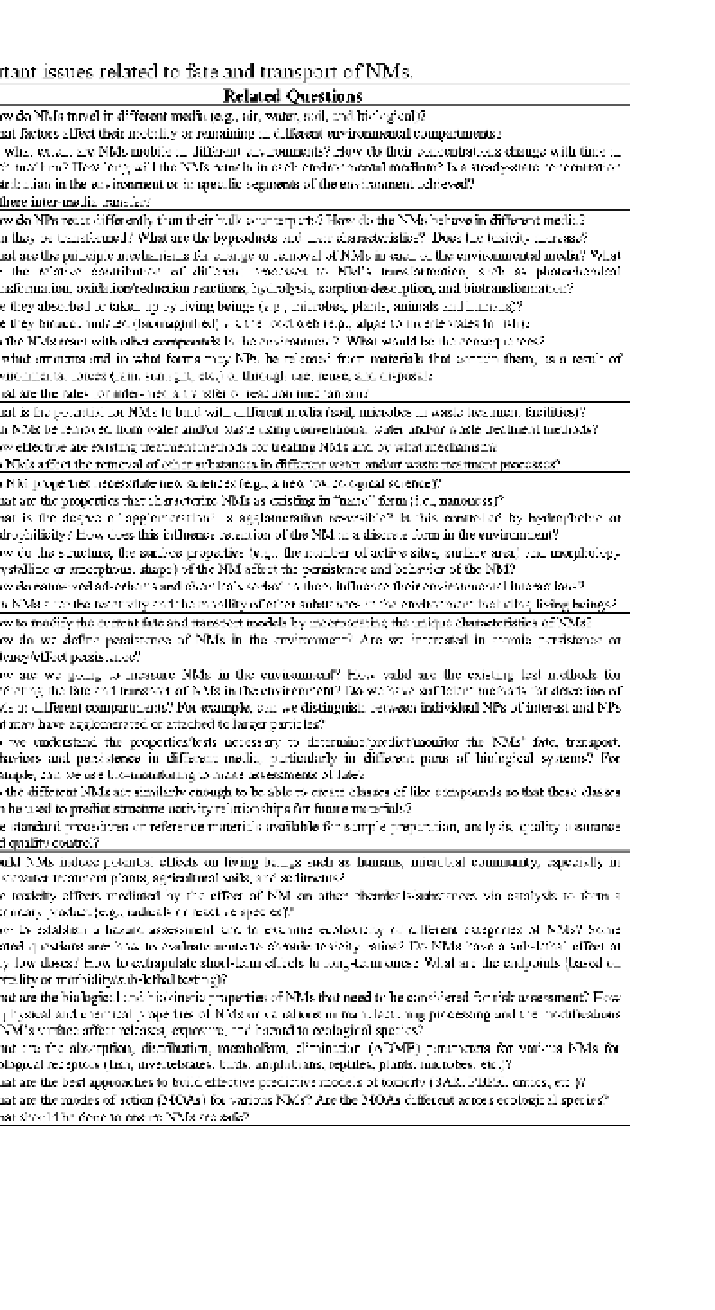Environmental Engineering Reference
In-Depth Information
Table 15.1
Important issues related to fate and transport of NMs.
Related Questions
• How do NMs travel in different media (e.g., air, water, soil, and biological)?
• What factors affect their mobility or remaining in different environmental compartments?
• To what extent are NMs mobile in different environments? How do their concentrations change with time in
each medium? How long will the NMs remain in each environmental medium? Is a steady-state concentration
distribution in the environment or in specific segments of the environment achieved?
• Is there inter-media transfer?
• How do NPs react differently than their bulk counterparts? How do the NMs behave in different media?
• Can they be transformed? What are the byproducts and their characteristics? Does the toxicity increase?
• What are the principle mechanisms for change or removal of NMs in each of the environmental media? What
are the relative contribution of different processes to NM's transformation, such as photochemical
transformation, oxidation/reduction reactions, hydrolysis, sorption/desorption, and biotransformation?
• Are they absorbed or taken up by living beings (e.g., microbes, plants, animals and humans)?
• Are they bioaccumulated (biomagnified) via the food web (e.g., algae to invertebrates to fish)?
• Do the NMs react with other compounds in the environment? What would be the consequences?
• In what amounts and in what forms may NPs be released from materials that contain them, as a result of
environmental forces (rain, sunlight, etc.) or through use, reuse, and disposal?
• What are the rates for inter-media transfer or reaction mechanism?
• What is the potential for NMs to bind with different media (soil, microbes in waste treatment facilities)?
• Can NMs be removed from water and/or waste using conventional water and/or waste treatment methods?
• How effective are existing treatment methods for treating NMs and by what mechanism?
• Do NMs affect the removal of other substances in different water and/or waste treatment processes?
• Do NM properties necessitate new sciences (e.g., a new toxicological science)?
• What are the properties that characterize NMs as existing in "nano" form (i.e., nanoness)?
. What is the degree of agglomeration? Is agglomeration reversible? Is this controlled by hydrophobic or
hydrophilicity? How does this influence retention of the NM in a discrete form in the environment?
• How do the structure, the surface properties (e.g., the number of active sites, surface area) and morphology
(crystalline or amorphous, shape) of the NM affect the persistence and behavior of the NM?
• How do nanosized adsorbents and chemicals sorbed to them influence their environmental interactions?
• Can NMs alter the reactivity and the mobility of other substances in the environment including living beings?
• How to modify the current fate and transport models by incorporating the unique characteristics of NMs?
• How do we define persistence of NMs in the environment? Are we interested in atomic persistence or
potency/effect persistence?
• How are we going to measure NMs in the environment? How valid are the existing test methods for
predicting the fate and transport of NMs in the environment? Do we have sufficient methods for detection of
NMs in different compartments? For example, can we distinguish between individual NPs of interest and NPs
that may have agglomerated or attached to larger particles?
• Do we understand the properties/tests necessary to determine/predict/monitor the NMs' fate, transport,
behaviors and persistence in different media, particularly in different parts of biological systems? For
example, can we use bio-monitoring to make assessments of fate?
• Do the different NMs act similarly enough to be able to create classes of like compounds so that these classes
can be used to predict structure-activity relationships for future materials?
• Are standard procedures or reference materials available for sample preparation, analysis, quality assurance
and quality control?
• Could NMs induce potential effects on living beings such as humans, microbial community, especially in
wastewater treatment plants, agricultural soils, and sediments?
• Are toxicity effects mediated by the effect of NM on other chemicals/substances via catalysis to form a
secondary product (e.g., radicals or reactive species)?
• How to establish a hazard assessment and to examine ecotoxicity of different categories of NMs? Some
related questions are: how to evaluate acute to chronic toxicity ratios? Do NMs have a sub-lethal effect at
very low doses? How to extrapolate short-term effects to long-term ones? What are the endpoints (based on
mortality or morbidity/sub-lethal testing)?
• What are the biological and biokinetic properties of NMs that need to be considered for risk assessment? How
do physical and chemical properties of NMs or variations in manufacturing processing and the modifications
of NM's surface affect releases, exposure, and hazard to ecological species?
• What are the absorption, distribution, metabolism, elimination (ADME) parameters for various NMs for
ecological receptors (fish, invertebrates, birds, amphibians, reptiles, plants, microbes, etc.)?
• What are the best approaches to build effective predictive models of toxicity (SAR, PBPK, omics, etc.)?
• What are the modes of action (MOAs) for various NMs? Are the MOAs different across ecological species?
• What should be done to ensure NMs are safe?

Search WWH ::

Custom Search